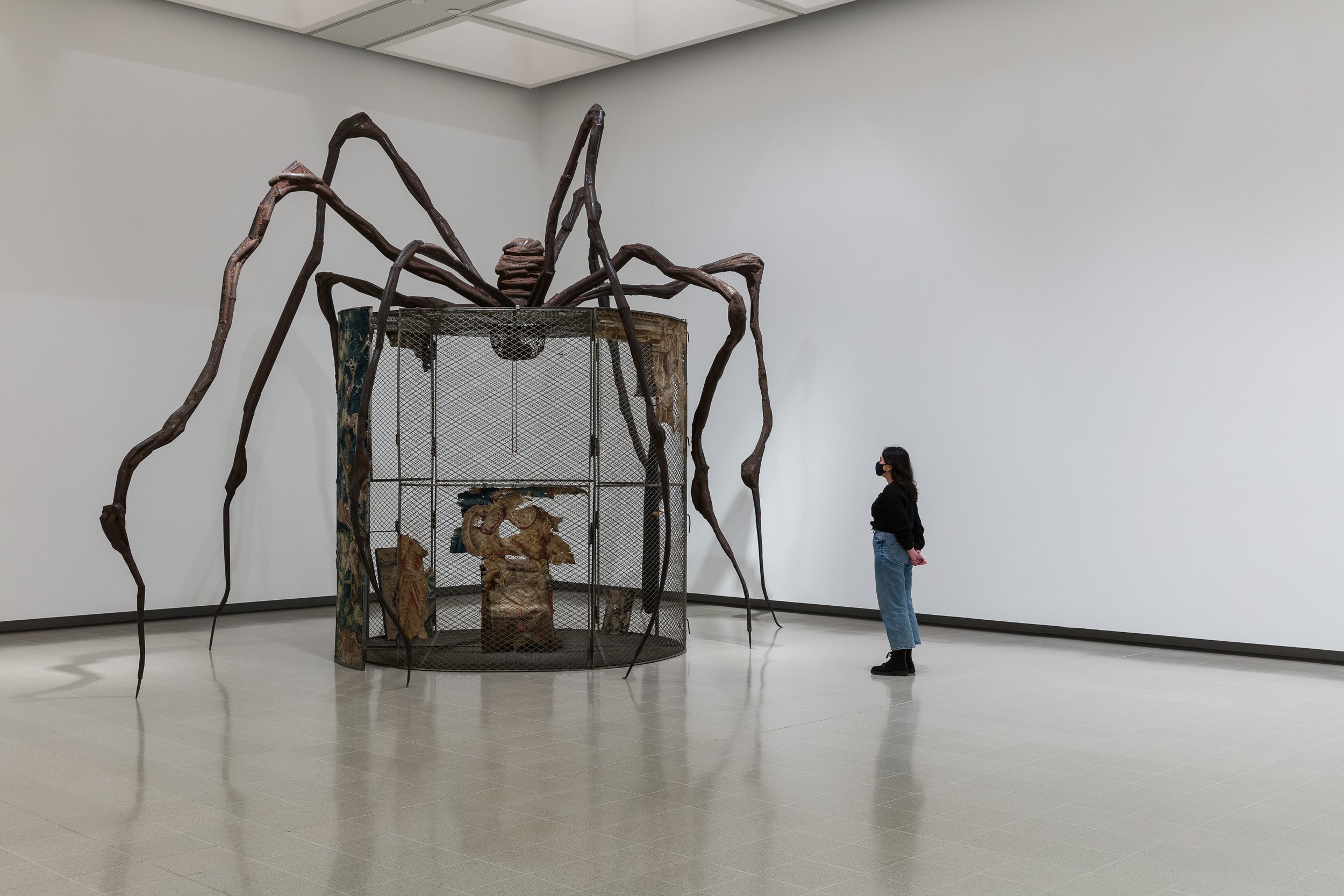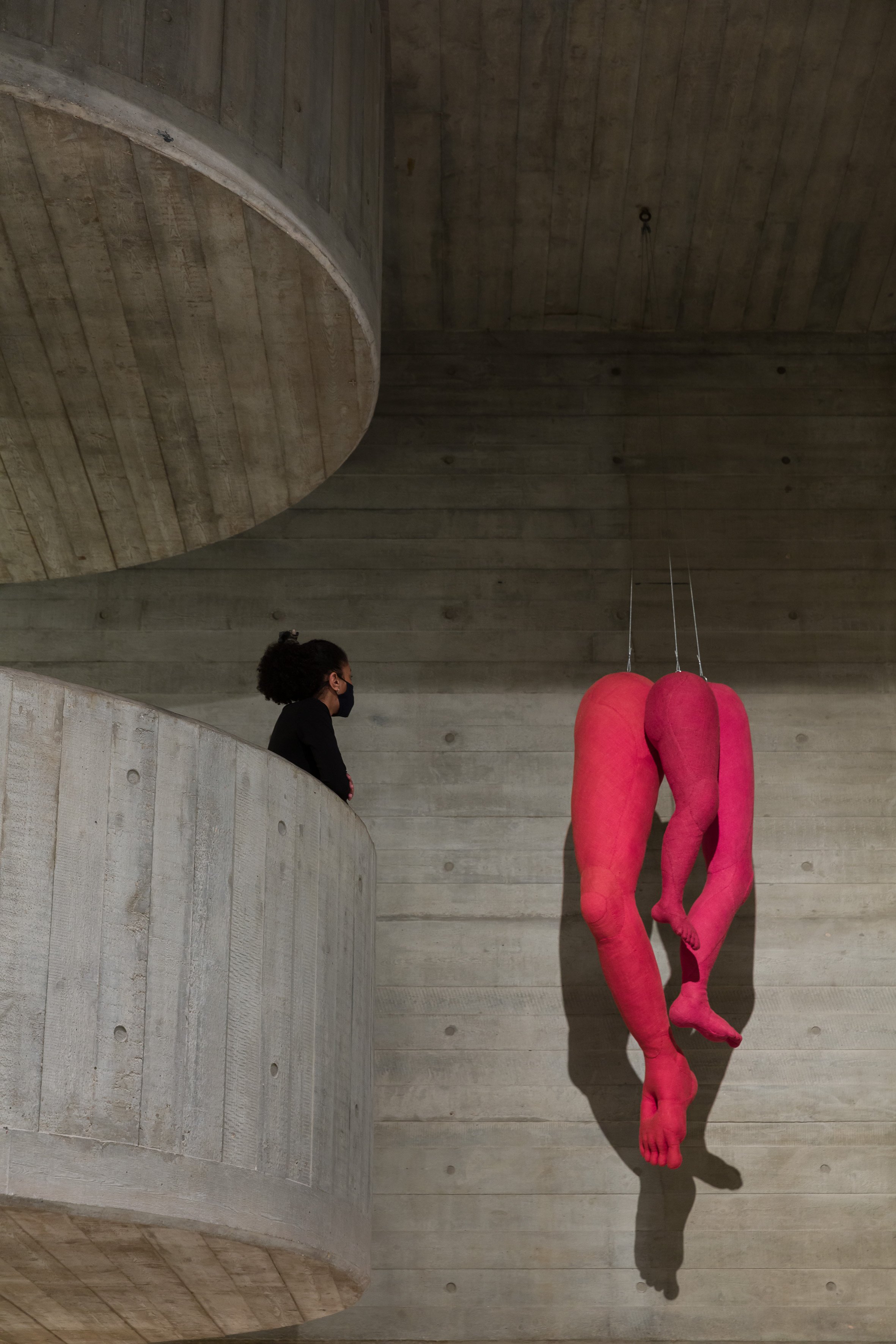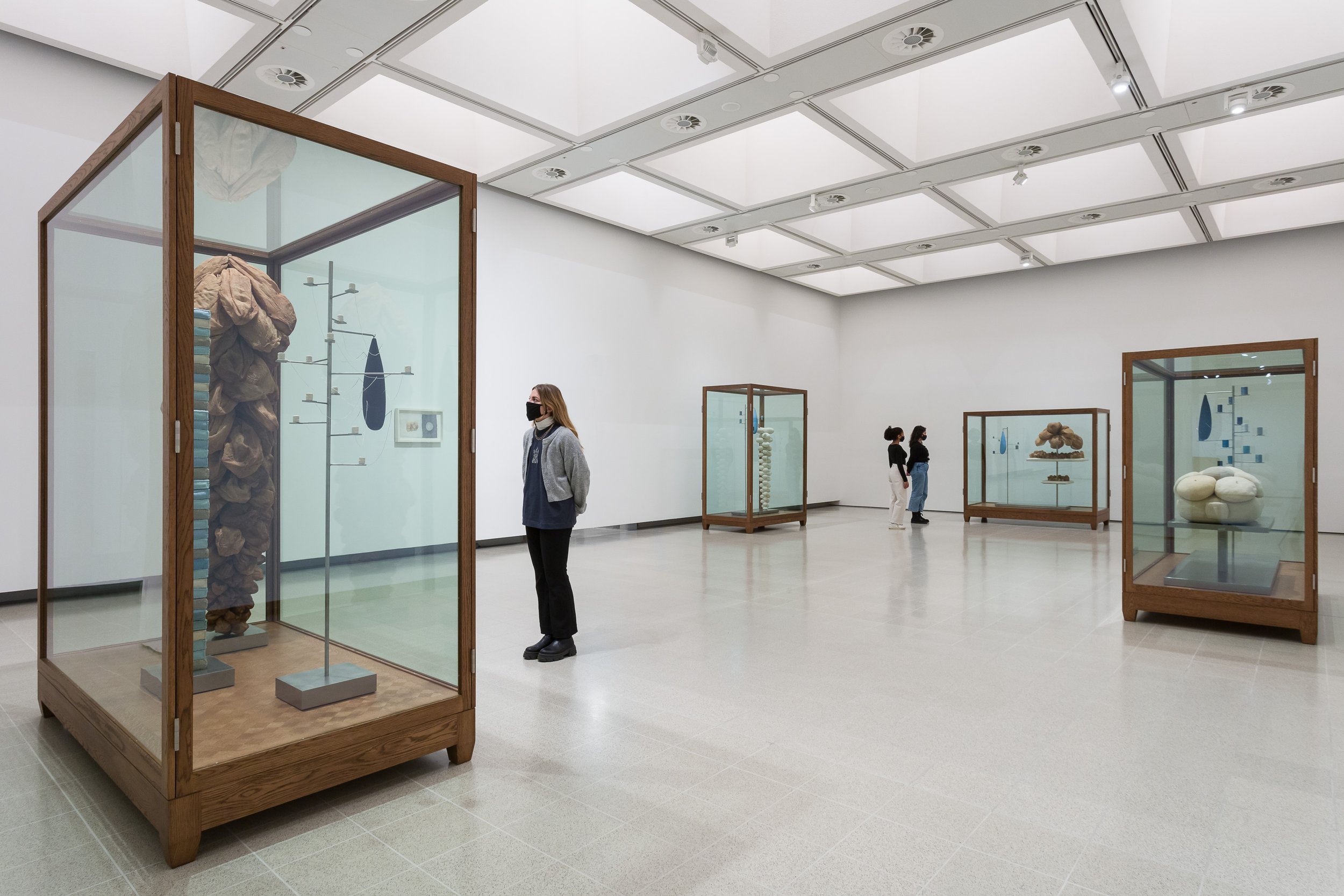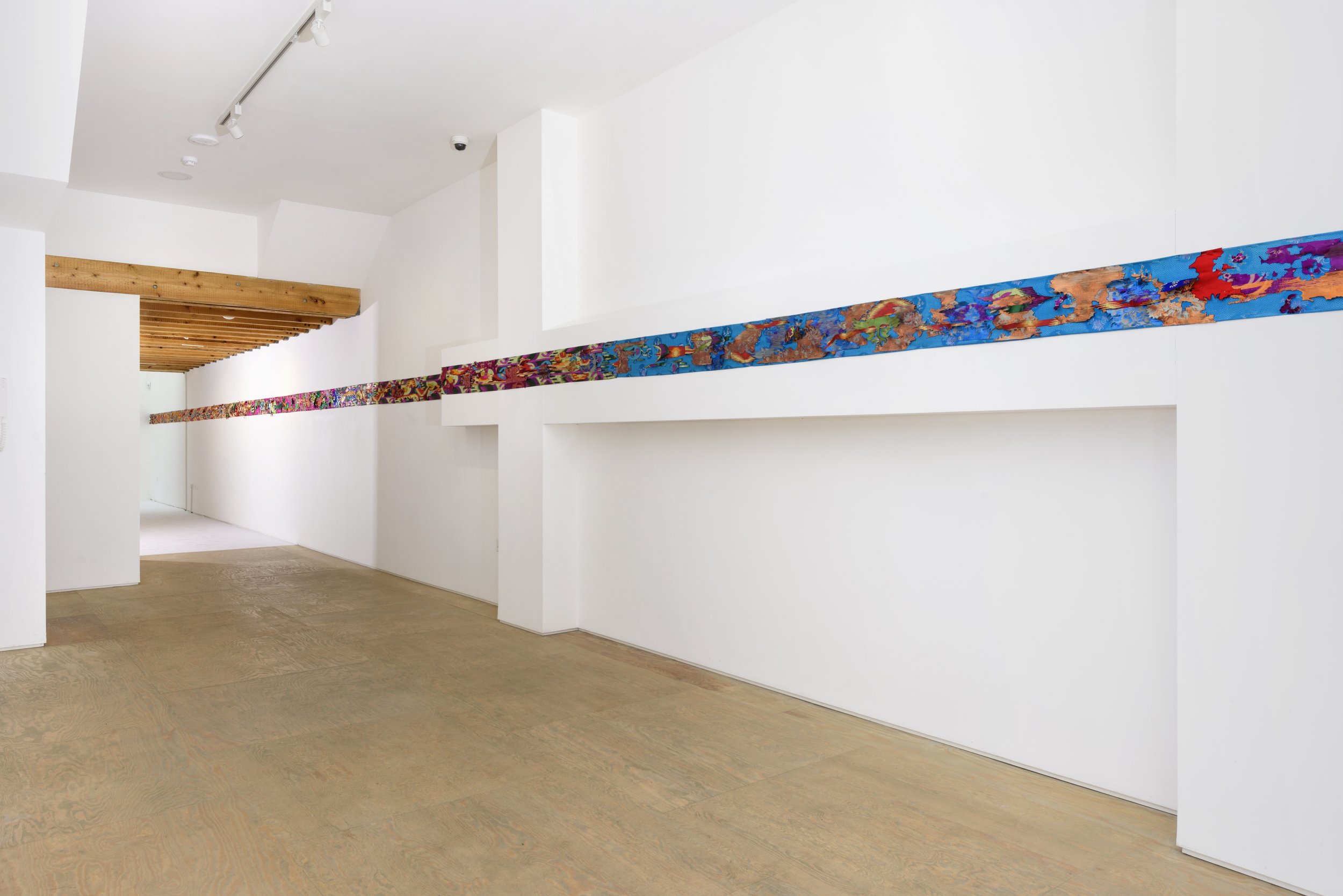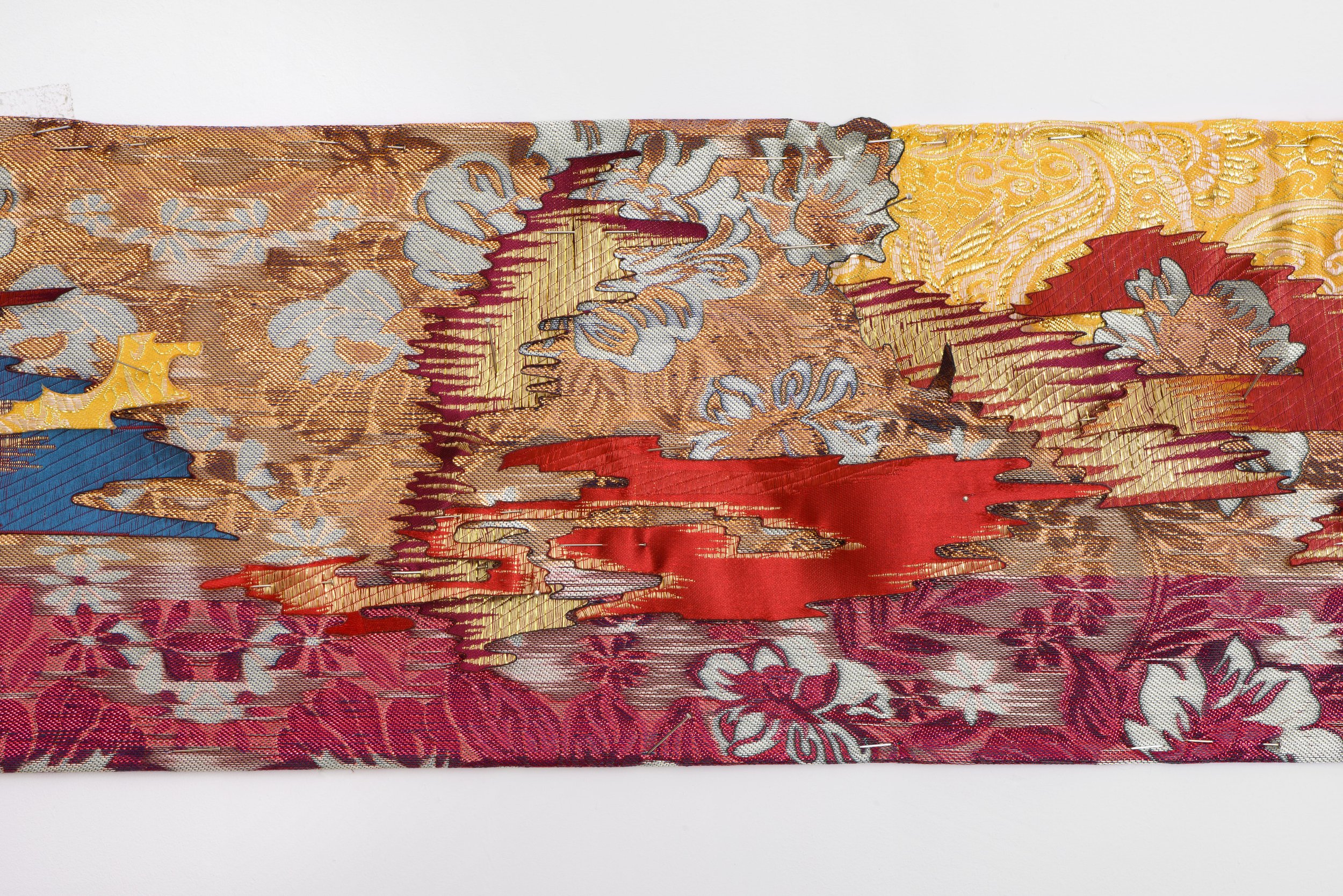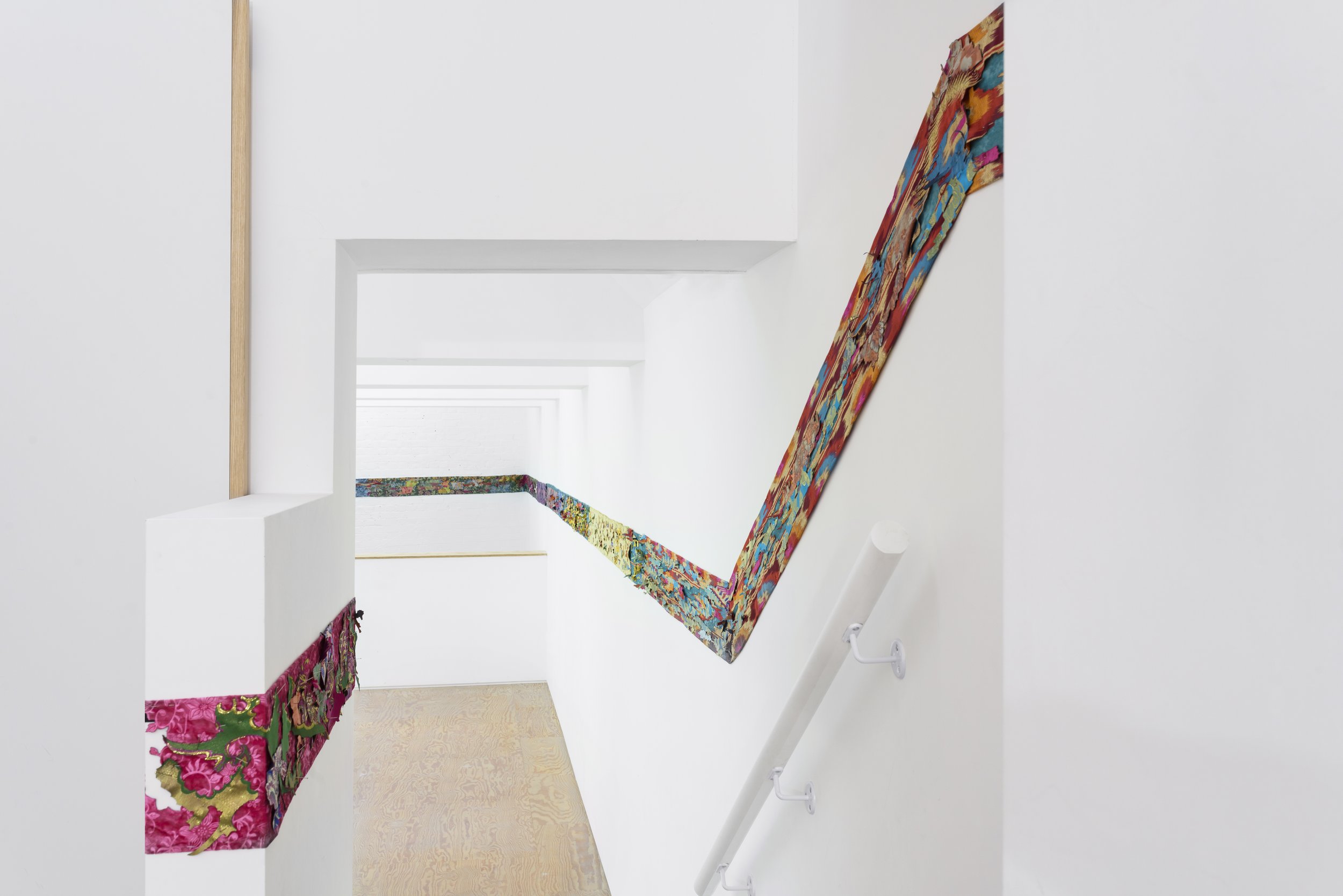Can one mend trauma with a thread?
New exhibitions from Louise Bourgeois and Gulnur Mukazhanova can be disturbing, or they can be healing – depending on where you are at, emotionally and psychologically.
Installation view of Louise Bourgeois: The Woven Child at Hayward Gallery, 2022. © The Easton Foundation/DACS, London and VAGA at Artists Rights Society (ARS), New York. Photo: Mark Blower/© The Hayward Gallery
Louise Bourgeois worked with themes of sexuality, motherhood, and loss in her earliest works, then continued with these subjects in the last decades of her life when fabric became her medium of choice.
Bourgeois is most famous for her giant spider sculptures. You will find one at the Hayward Gallery show. The largest, Maman, was displayed at Tate Modern’s opening in 2000. However, she only began creating them in the 1990s, while her career as an artist started back in the late 1930s. Initially she worked with paintings and prints, but quickly moved to sculptures. These became progressively larger. She proceeded from abstract forms such as spirals to depictions of the human body, most notably breasts, genitalia, and limbs.
Installation view of Louise Bourgeois: The Woven Child at Hayward Gallery, 2022. © The Easton Foundation/DACS, London and VAGA at Artists Rights Society (ARS), New York. Photo: Mark Blower/© The Hayward Gallery
Spiders, for the artist, were a metaphor for her mother. Her family business was in tapestry repair and the way spiders weave their webs reminded her of how her mother worked carefully and meticulously on her tapestries. Her own interest in textiles and the way they linked back to her early life resurfaced in the last two decades of it – mid 1990s to 2010 – through her works.
Each piece in the show The Woven Child feels extremely personal. From the first room the visitor is faced with ghostly sheer garments suspended from bones. We discover that those garments belonged to Louise Bourgeois and her mother. There is a constant presence of death, loss and trauma.
Installation view of Louise Bourgeois: The Woven Child at Hayward Gallery, 2022. © The Easton Foundation/DACS, London and VAGA at Artists Rights Society (ARS), New York. Photo: Mark Blower/© The Hayward Gallery
But there is also a glimpse of hope. Bourgeois defended the needle – that sharp, piercing object – as an agent of repair, of healing. It facilitates the joining together of that which has been ripped apart. It also allows creation of the new out of the old. These processes act therapeutically on both body and mind.
This exhibition starts with a medium – textiles; analyses the entirety of Bourgeois’ practice in it; and in doing so discovers the artist’s own form of autobiography. This survey of her own life started as a cupboard declutter – but with quite different parameters to Marie Kondo. She kept those things that evoked memories, rather than joy. She then used them intact within larger installations. The rest were cut up and used as base material for her sculptures or sewn ‘drawings’.
Installation view of Louise Bourgeois: The Woven Child at Hayward Gallery, 2022. © The Easton Foundation/DACS, London and VAGA at Artists Rights Society (ARS), New York. Photo: Mark Blower/© The Hayward Gallery
While the materials used are deeply personal, the shape they take is highly charged. Antagonism between sexes is highlighted and problematised. A mannequin with a dress on it becomes a phallic shape, sagging breasts double as sagging phalluses. Her way of working with the material is also curious – it is deliberately obvious – the stitches aren’t there to conceal the transformation, but to emphasise it.
Everything we see in this show originates in that cupboard. That is one decluttering goal indeed! Bourgeois likened her beloved spider not only to her mother, but to her own art practice. Spiders have the ability to restore broken webs, but even more importantly use their own body to make the web in the first place. The final works in the exhibition are large glass cases into which the artist placed various sculptural works, uniting them in a museum-like presentation. Created during her last five years, they are the ultimate combination of her life, art, and image as an artist.
One question I ask myself when seeing such personal, trauma-driven art is: to what point can the audience engage with it? Those who have not faced trauma in their life – will they feel it in these works? Would that make these works a sort of dark entertainment? For those who went through trauma – will this be a reminder or a release? Would they see their own life through the lens of Bourgeois’?
Installation view of Louise Bourgeois: The Woven Child at Hayward Gallery, 2022. © The Easton Foundation/DACS, London and VAGA at Artists Rights Society (ARS), New York. Photo: Mark Blower/© The Hayward Gallery
Textiles are a challenging material. For the viewer, they offer their visual self but leave a gap – their tactile nature combined with the inability to touch. Gulnur Mukazhanova’s entire practice revolves around fabrics and textiles and the way they can tell stories of past and present.
Installation view of Gulnur Mukazhanova, Öliara: The Dark Moon, organised by Ainalaiyn Space, at Mimosa House, 2022.
Her new show Öliara: The Dark Moon is all about metaphor – although the grave covered with flowers in the centre might give it away. As could the uncomfortable sounds: a mixture of sirens, machinery and the melancholic kobyz – a Kazakh music instrument that is believed to ward off evil spirits. Both are parts of the main installation entitled The Horizon Line, which is a long, thin line of fabric that stretches around the entire gallery space. As wide as an A4 sheet of paper, the line seems endless in length, as wherever you look within the gallery, there it is at eye level.
Mukazkanova’s works include ‘paintings’ made out of hand-felted wool, brightly coloured lurex, velour, and real and polyester silks. She now lives in Berlin, but is originally from Kazakhstan, where she studied textiles. She remains fascinated by them and has a collection of fabrics from different cultures. Whether Indian, Moroccan, Chinese or Japanese – fabrics, she says, carry with them a story of not only the culture they come from, but also the origins of these cultures.
Installation view of Gulnur Mukazhanova, Öliara: The Dark Moon, organised by Ainalaiyn Space, at Mimosa House, 2022.
While looking for materials in the markets in Almaty, Kazakhstan and Tashkent, Uzbekistan, Mukazhanova discovered that she could not only find new textiles, but those from the past. Sometimes these are beautiful pieces of craft, others are simply unused fabrics. Both are carefully preserved and passed from generation to generation of women.
Textiles played many roles in the transmission of messages at principal events within Kazakh culture. Fabrics were given to special guests at weddings; brides would bring beautiful household textiles as part of their dowry; women would leave their most treasured items of clothing and hand-made blankets as inheritance for their grand-daughters.
Detail of The Horizon Line, at Gulnur Mukazhanova, Öliara: The Dark Moon, organised by Ainalaiyn Space, at Mimosa House, 2022.
Mukazhanova received such an inheritance from her grandmother. This made her particularly interested in the traditional techniques and uses of fabrics, but also in the loss of these traditions. In her works, she revives some of them – felting for example, but with streamlined colour palette, giving centre stage to fabrics and their combinations. Using found and new fabrics allows her to combine the past and the present in one piece.
In all her works with felt, Mukazhanova addresses loss of memories – loss of the links to ancestors, who are being forgotten. She takes it on herself to attempt a revival in the deeper feeling for the textile, for traditional methods of felting, to avoid what she calls an ‘absurd use of this material just as an attribute of pseudo-tradition’.
Installation view of Gulnur Mukazhanova, Öliara: The Dark Moon, organised by Ainalaiyn Space, at Mimosa House, 2022.
The theme of falseness is continued and expanded in works with synthetic silks such as The Horizon Line. Layer over layer of shiny fabrics is precariously, barely held together by pins. She is referring to the falseness of modern society – from broken political promises to enhanced personal presentation on social media.
The materials Mukazhanova uses are not accidental. For example, combining both fake and real versions of what once was a precious material – silk – is a deliberate reference to Central Asian history, a region that lay on the Silk Road. In a further twist, these polyester fabrics gained popularity in Kazakhstan in the 1990s as a gift to guests at weddings, subverting the tradition of giving real fabrics at these occasions. Their bright shiny nature makes them seem extravagant, however their low quality results in them being left unused. Often regifted at future events, they become a symbol of artificial, fake interactions.
Installation view of Gulnur Mukazhanova, Öliara: The Dark Moon, organised by Ainalaiyn Space, at Mimosa House, 2022.
The Horizon Line is an exploration of the value of human life, its fragility as well as illusions of the modern world. It refers directly to the seemingly endless loss of life and suffering that characterize the last several years – from Covid to protests to wars. Fabrics are often seen and portrayed as ‘soft’ material – something traditionally associated with the female, the household and the personal. In these two exhibitions we see how sharp and piercing they can become in the right hands.
Louise Bourgeois: The Woven Child, 09 February – 15 May 2022, Hayward Gallery
Gulnur Mukazhanova: Öliara: the Dark Moon, 18 March – 30 April, Mimosa House, organised by Ainalaiyn Space
This article first appeared on Tiesennotes

